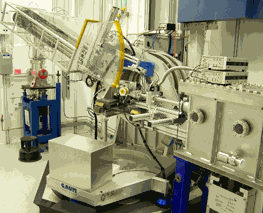The MERIX (medium resolution inelastic x-ray scattering) spectrometer was successfully commissioned in November-December 2006 at the sector 30 beamline of the Advanced Photon Source (APS). The spectrometer (Fig. 1), was designed, manufactured, and installed on the APS experiment hall floor by a collaborative design team comprising scientists and engineers from Argonne, Brookhaven National Laboratory, and Western Michigan University. The MERIX spectrometer will be used for the study of collective valence electron excitations in correlated electron systems, primarily of transition-metal oxides.
The x-ray photon energy range of MERIX is 5-12 keV and the targeted energy resolution is ~100 meV. A basic feature of the inelastic cross section in the 5-12 keV range is the presence of resonances at transition metal (and other) absorption edges. As a result of these resonances, there are certain key energies at which the spectrometer will work (a principal one being the Cu K-edge). Understanding the polarization dependence of the scattering at resonance is crucial. This will be addressed by the ability of the spectrometer to scatter both vertically and horizontally.
The MERIX instrument is equipped with mirrors, providing microfocused beam on the sample—5 µm in the vertical direction and 40 µm in the horizontal direction—enabling studies of small samples and samples under high pressure. The MERIX monochromator delivers to the sample x-ray photons in the 70-meV- or 120-meV-energy bandwidths. The flux in the microfocused beam of 9-keV photons on the sample is 1.4 THz (70 meV) or 2.0 THz (120 meV). The energy resolution of the spectrometer at the Cu K-edge resonance is 115 meV. Figure 2 shows the resonant inelastic x-ray scattering spectrum measured in GeCuO3 sample with 8.99-keV photons; measurement time was two hours.
Additional capabilities to be brought on line in the future include analyzers for K-edges of other transition metals, sample temperatures of 4K to 500K, high pressure, and other sample environments.
MERIX became a user instrument (with 50% of beam time allocated for general users) in February of 2007.
— Yuri Shvyd'ko
Contact: Yuri Shvyd'ko (shvydko@aps.anl.gov)
Use of the Advanced Photon Source was supported by the U. S. Department of Energy, Office of Science, Office of Basic Energy Sciences, under Contract No. DE-AC02-06CH11357.


